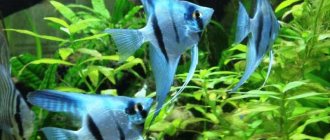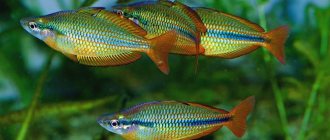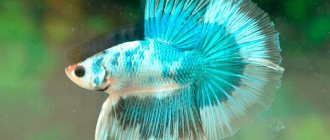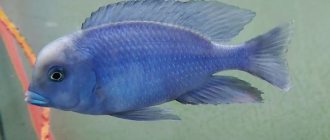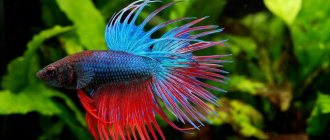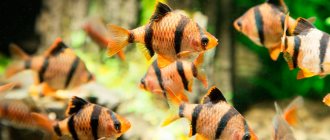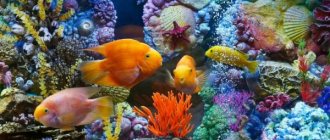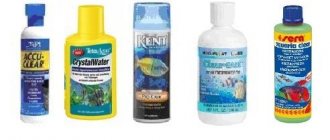Would you like to have an exotic and beautiful fish in your aquarium? Then pay attention to the surgeon. The surgeon fish (lat. Acanthurus Forsskål) is very beautiful, looks great in a reef aquarium and does not require very complex care. On the other hand, surgeonfish are not recommended for beginners and can be dangerous.
Surgeon fish
On a note ! Tangs are one of the most common and favorite fish in the marine aquarium. Spectacular and rather unpretentious pets belonging to the Surgical family.
Description
Surgeonfish are usually kept in reef marine aquariums. They search for food throughout the entire aquarium.
Surgeonfish get their name due to the presence at the base of the caudal fin, hidden in a calm situation, a poisonous lancet-shaped spine. Used to intimidate the enemy. In extreme cases, it can hit. It is not fatal to humans, but it is painful.
If you get hit by a “hot” tail, wash the wound with hot water or heat it in another way. Heating causes the breakdown of toxins. Don't stop the bleeding, let the poison come out.
Appearance
The body shape is an elliptical disk, the color is from light blue to blue with a dark purple pattern. The back and anal fins are the same color as the body, with an outer dark border. The caudal fin is trapezoidal, lemon yellow, with a body pattern continuing along the edges. In some cases, the pectoral fins and abdomen of the blue tang have a yellowish tint.
The mouth is small and directed forward. The eyes are large. The typical length in an aquarium is 20–22 cm.
Lifestyle
Active during the day, young fish gather in schools, adults are solitary. The exception is the harem. Territoriality is expressed, but is not aggressive outside the domain.
They love to nibble on algae. Resting in the bushes. Not shy. They fight back against aggressive neighbors. They sleep in an upright position or on their side. Need shelters. Hepatus do not dig the soil, do not damage equipment and do not encroach on corals.
Lifespan
In captivity they live 12–20 years.
Reproduction of surgeons
In an aquarium, it is quite difficult to obtain offspring from a surgeon fish, but there are known cases of successful hatching of fry. To achieve results, it is necessary, first of all, to create a favorable atmosphere as close as possible to the natural environment of surgeons. The huge volume of the aquarium plays an important role in this, which is often extremely difficult to achieve at home.
Vlaminga rhinoceros Naso vlamingii and doctor wrasse
On a note ! The surgeon reaches puberty after one year. But at the same time, sexual differences are not pronounced: a male can be distinguished from a female only during mating (his color becomes paler).
After mating, the female lays about 30,000 eggs, each less than 1 mm in diameter, on wide algae. Embryonic development continues for several days. Surgeon fry, unlike adults, are almost transparent and do not have poisonous spines at all. Phytoplankton should be taken to feed the fry.
Surgeon
Kinds
The surgical family includes 6 genera. Representatives are similar in body shape. They differ in color and size. Conditions of detention are approximately the same.
Arabian tang, sohal (Acanthurus sohal)
Otherwise - an Arabian surgeon. Belongs to the genus Surgeon Fish (Acanthurus). In nature, it is found on the reefs of the shallows of the Arabian coast of the Indian Ocean, the Red Sea and the Persian Gulf. Territorial, aggressive, attacks people when boundaries are violated.
In the wild it grows up to 40 cm. The color is gray with purple stripes, in some cases they form patterns. The abdomen is light. The anal and dorsal fins, the caudal fins are purple. The spines and gill space are highlighted in warning orange. The caudal fin is shaped like a rotated "Ω" symbol.
In captivity, males get along poorly with all fish except the harem. Eats mollusks and crustaceans. For one individual, a vessel of 0.7 m3 is required. With a harem - from 1 m3.
Zebrasoma
The genus Zebrasoma includes 7 species. Yellow zebrasomes (Zebrasoma flavescens) are common in aquariums. In nature, they are found on tropical reefs of the Pacific and Indian Oceans, the Red Sea and the Persian Gulf. The species is endangered due to uncontrolled fishing.
Expert opinion on content complexity
Experienced aquarists, after numerous observations, have concluded: the most difficult stage of keeping surgeons is the moment of adaptation to new conditions after acquisition . This is explained by the weak immune system of fish. But when the adaptation period is over, there will be no particular difficulties in caring for this species.
Japanese surgeonfish (bronze) Acanthurus japonicus
Feeding
In the natural environment, the blue tang eats zooplankton and algae. In an aquarium, 70% of the diet is plant food. He will get his own greens. To prevent eating algae, give blanched vegetables, oatmeal, and spirulina tablets. Typically, sampa algae contains an excess of chaetomorpha. Send to blue pets.
Feed live or frozen food a couple of times a week. The meat of shrimp, mussels, and sea fish fillets are healthy.
Feed 1-2 times a day. A weekly fasting day is required.
Reasons for the name
The fish is called the “blue surgeon” because of the specific fin on its tail. The surface of this part of the body has sharp plates that are hidden under skin folds in a calm state, but are instantly exposed in case of danger.
With the help of the fin, members of the family defend themselves, avoiding contact with people or other inhabitants of the depths. They often attack divers who do not know how dangerous the fish is and try to pet it.
Therefore, if you receive cuts, you should treat the wound with an antiseptic. You should also take antihistamines, as sharp thorns can cause allergies.
Diseases
Blue tangs get sick easily. With timely treatment, they recover safely. A common disease is cryptokaryon.
Cryptokaryon is caused by parasites present in seawater. Wild-caught fish are highly likely to be contaminated. The disease manifests itself due to the stress of moving and weakened immunity. Symptoms: the appearance of white growths 0.5–1 mm in diameter. As the disease progresses - up to 2 mm.
For treatment, place the sick blue pet away. Pet stores sell copper-containing preparations (copper sulfate). Dilute according to the attached instructions. Treatment lasts 2–4 weeks. Procedures in a community aquarium are not possible due to the presence of corals that cannot tolerate copper.
To prevent the disease, regular water changes and UV irradiation of the main jar or sump are recommended.
Reviews from aquarists about the surgeon fish
Konstantin Skitetsky, review of the blue (royal) surgeon:
“A peaceful and good fish, has a beautiful color, loves to sleep in a hole in the stones. Eats almost everything, does not touch other fish. Although occasionally it may be possible to drive the same surgeon.”
Victor Sotnichenko, review of the blue (royal) surgeon:
“It has a beautiful color, especially in good lighting. The behavior of the fish is uninteresting and even boring, it just swims around the aquarium back and forth. I don’t know about other surgeons, but mine is quite boring, especially when compared with predators - they are much smarter and more interesting in behavior. I recommend purchasing only to those who like screensaver fish (that is, those with a background function).”
Olga Alekseeva, review of the yellow-tailed zebrasoma:
“Beautiful and neat zebrasoma. He loves to eat salad, which also replaces frozen food. Occasionally suffers from attacks from the yellow zebrasoma."
Surgeonfish are large marine creatures, often with complex personalities. They are so freedom-loving that they do not breed in captivity. However, watching them is always a great pleasure!
Photo gallery
Compatibility
Most species prefer a solitary existence and react aggressively to relatives. Compatibility depends on many factors:
- aquarium volume;
- temperament;
- the presence of shelters;
- age;
- feeding, etc.
There are also non-conflict types:
- The most peaceful ones are blue and white-breasted.
- It is advisable to keep one at a time - Arabian, zebra.
- Gets along with anthias, wrasse, angelfish - blue tang.
The White-breasted Tang is a beautiful and peaceful aquarium fish.
Diseases
Surgeon fish are naturally endowed with high susceptibility to many diseases. Particularly dangerous:
- Ichthyophthiriasis - whitish spots suddenly appear on the gills and fins, which very quickly spread to the body.
- Oodiniosis - at the beginning, the fish swims up to the reefs and seems to “itch” against them. Then a gray coating appears on the body and fins. The radial tissue of the fins and the cover are quickly destroyed, and mucus formation is observed.
There are also less dangerous diseases: fin rot, purulent erosion of the head.
Nutrition
Representatives of the species are herbivores, feeding on algae, zooplankton and detritus. If there is not enough food or there is too much competition, they gather in flocks to search for shared food. Such “trips” for food collect up to several thousand fish, which after feeding disperse to their usual habitats. Also gathering in flocks occurs during the breeding season.
Habitat (Where does it live?).
The surgeonfish prefers to live on the outer slopes at a depth of up to 40 m between corals and in rock crevices
Geographically, they can be found throughout the Indo-Pacific region. They have been spotted in reefs in the Philippines, Indonesia, Japan, Australia's Great Barrier Reef, New Caledonia, Samoa, East Africa and Sri Lanka.
Where does the surgeon fish live?
Fry live in schools, adult fish prefer to live in pairs or small groups of 8 to 14 individuals. In rare cases, when there is an acute shortage of food, they can gather in large flocks containing up to 1000 individuals. However, these alliances are short-lived. As a rule, when saturated, they immediately disintegrate.
